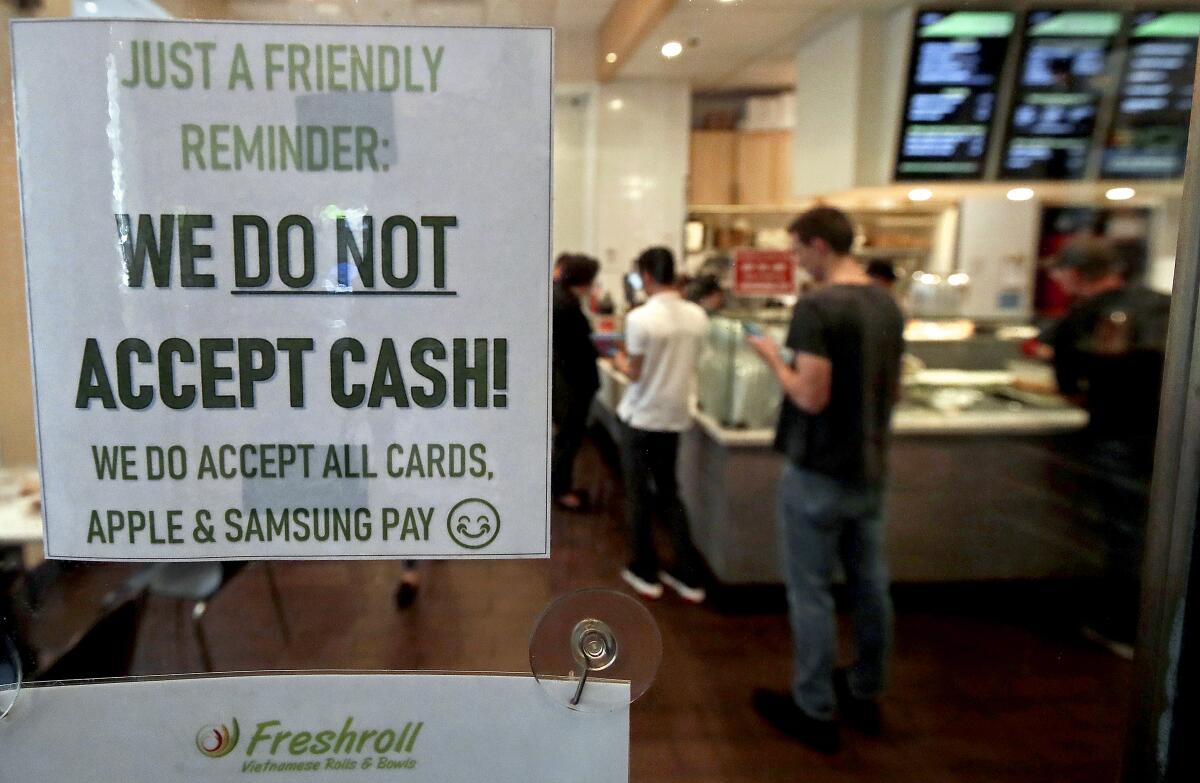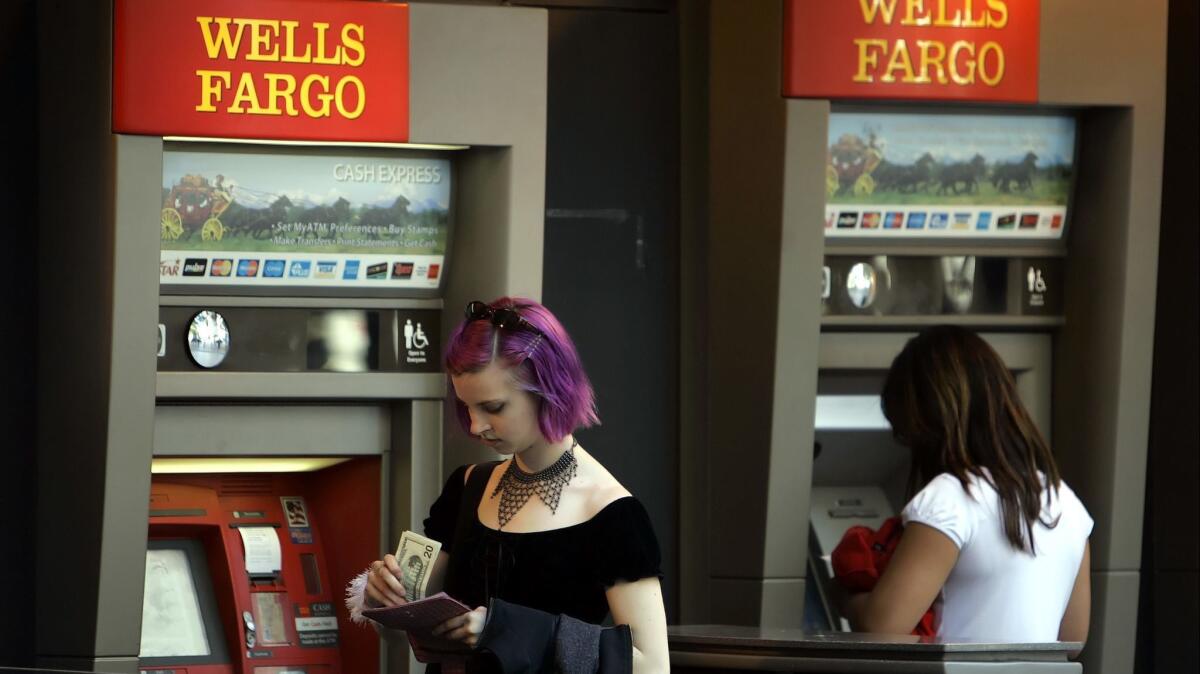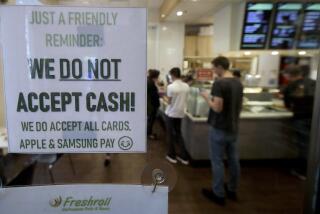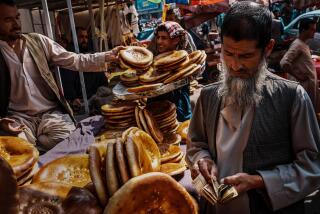Fear of coronavirus-tainted dollars opens a new front in the war on cash

The signs began appearing around Seattle in the windows of Dick’s Drive-In, the city’s iconic burger chain: “In an abundance of caution, we ask you to please pay with credit or debit card if possible rather than cash.”
Fear of paper dollars is now palpable in the U.S. epicenter of the coronavirus.
And across the financial industry, a rigorous debate is brewing over how to address the public’s mounting concern that greenbacks might transmit COVID-19. Studies show it’s at least theoretically possible for other coronaviruses to survive on the dollar’s cotton-and-linen weave, though there’s little agreement on the actual risk of contagion.
Behind the scenes, some industry groups and banks have been urging the Federal Reserve and Treasury Department to issue a statement assuring Americans that there’s minimal risk for using cash, according to people with knowledge of the discussions. The Fed, in turn, says it’s waiting for advice from the Centers for Disease Control and Prevention, which so far has said the virus spreads primarily through person-to-person contact. In the meantime, the Fed has been putting notes repatriated from Asia in quarantine for up to 10 days to ensure they are safe.
The stakes are high for banks and companies handling electronic payments: Billions of dollars in profits hinge on whatever statement or policy authorities ultimately issue.
On one side, small and mid-size banks are working to keep branches open so they can keep serving legions of business customers that refill their cash registers daily. Representatives from some lenders think it’s important for regulators to offer guidance on handling money, noting the risk of using currency is low — comparing it, say, to pushing an elevator button or grasping a handrail.
If, on the other hand, authorities take steps that discourage the use of dollar bills, it will buttress the credit card industry’s long-running “war on cash,” sending more transactions through their networks and to payment apps that collect fees. That could even boost interest-bearing credit card balances.
Firms such as Visa Inc., Mastercard Inc., American Express Co., PayPal Holdings Inc. and a slew of large card-issuing banks would be among the top beneficiaries.
The virus may end up serving as a “trigger event” for wider acceptance of cards long term, either persuading retailers to start taking them or prompting the government to force them, said Lisa Ellis, an analyst with independent research boutique MoffettNathanson. The shift would be especially dramatic in regions of the world where card use is still relatively uncommon, she said.
“Digital payments are already viewed as good for society by governments because they help with financial inclusion, they drive tax revenue and eliminate corruption,” she said. “This is another reason: ‘Oh, and it’s hygienic too.’”
And on another side are millions of Americans who lack access to bank accounts, as well as poor and rural communities with few if any branches serving residents and local businesses. Many of them rely on cash for commerce. Repeatedly in recent years, consumer advocates have fought stores and restaurants that try to simplify checkout by going “cashless.” Cities such as New York, Philadelphia and San Francisco passed laws requiring dollars be accepted.
Some of those groups worry they’re about to face a national battle to allow cashless commerce in response to the coronavirus.
“Going cashless is definitely not something that we particularly support,” said Eric Espinoza, an associate director at Neighborhood Trust Financial Partners, which helps provide financial services to low-income communities. “We certainly wouldn’t support it under a hasty decision-making environment in which you’re extremely reactive and potentially not as thoughtful about the repercussions.”
Despite the increased popularity of credit and debit cards in recent years, cash still remains one of the most popular ways to pay for things in the United States, accounting for 26% of all payments by consumers last year, according to data compiled by the Fed. Spare change and dollar bills are still overwhelmingly favored for small purchases, accounting for about 50% of payments under $10.
Roughly 25% of Americans are either unbanked or underbanked — with black and Latino households making up the largest percentage of those lacking accounts, according to a study by the Federal Deposit Insurance Corp. More than half of unbanked households in the United States say they lack the funds to keep an account open.

“If you want to go that direction, it’s going to take really thoughtful planning in order to deal with the questions of inclusivity,” John Thompson, chief program officer for the Financial Health Network. “There’s still really important, substantively sized sectors of the country that are operating outside of the mainstream financial system.”
Paper currency in the United States is made from 75% cotton and 25% linen, according to the Treasury. That makes the surface of bills coarse and fibrous, allowing germs to adhere more easily and survive longer than they can on smooth objects.
One study in 2013 showed the dollar has the ability to show “significant and prolonged carriage” of the dreaded Methicillin-resistant Staphylococcus aureus bacteria known as MRSA.
A 2020 study of coronaviruses, which included SARS and MERS, showed the microbes can persist on surfaces for as long as nine days. That can be reduced significantly using ethanol-based disinfectant, according to the study, but cleaning a paper bill proves more difficult than a plastic surface such as a desk.
Confronted with COVID-19, the People’s Bank of China began using ultraviolet light and high-temperature ovens to disinfect cash coming in. It has also replaced old notes with newly minted bills.
The Fed is staying in contact with the CDC to make sure it’s aware of the agency’s latest thinking on how the virus spreads, a spokeswoman for the central bank said.
So far during the current outbreak, the Fed hasn’t widely enacted its longstanding protocol for banks handling bills suspected of being dangerous: first stacking them in “straps” of 100, then bundling those into larger bricks and packaging them in plastic bags with the word “CONTAMINATED” scribbled in permanent ink.
Even if the virus compels more people to use cards, the world’s largest payments network will still be battling the broader slowdown in spending, especially in the travel sector.
“In the near term, at this point, coronavirus is a clear negative because of disproportionate impact on international travel and consumer discretionary spend,” Sanford C. Bernstein & Co. analyst Harshita Rawat said in an interview. “People are just not traveling internationally and this is one of the most profitable businesses that these companies have.”
More to Read
Inside the business of entertainment
The Wide Shot brings you news, analysis and insights on everything from streaming wars to production — and what it all means for the future.
You may occasionally receive promotional content from the Los Angeles Times.










